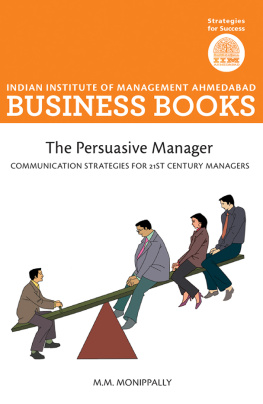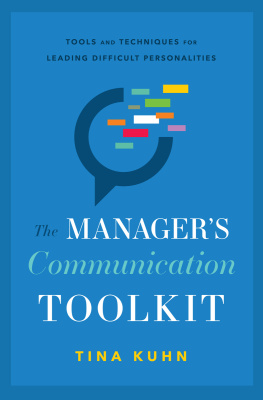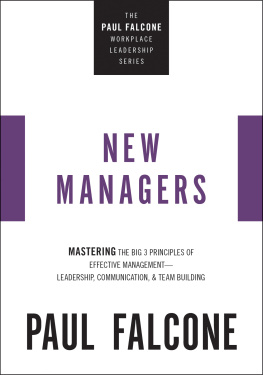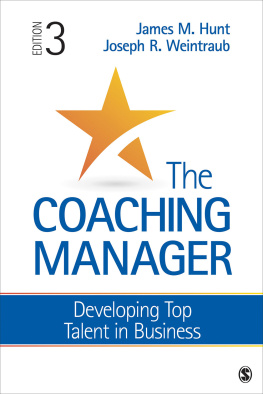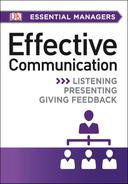Dear Reader,
The book you are holding is one of the books from the IIMA Business Books series published in collaboration with Random House to disseminate knowledge to executives in a manner that brings them up to date in different fields of management. The books are written by authors who have rich experience of teaching executives from a diverse set of organizations. Written in a conversational style with numerous illustrations from the world of experience, you will find the books useful in your work life. The references cited in the books provide you with ready information on where to look for more detailed information on specific topics and concepts. I am certain you will enjoy reading the book. Write to us suggesting topics that you will like being covered in the books that are to be published under the series in the future.
Samir K. Barua
Director
IIM Ahmedabad

INDIAN INSTITUTE OF MANAGEMENT AHMEDABAD
BUSINESS BOOKS
The Persuasive Manager
COMMUNICATION STRATEGIES
FOR ST CENTURY MANAGERS
M.M. MONIPPALLY

RANDOM HOUSE INDIA
Published by Random House India in 2010
Copyright Mathukutty M. Monippally 2010
Random House Publishers India Private Limited
MindMill Corporate Tower, 2nd Floor, Plot No 24A
Sector 16A, Noida 201301, UP
Random House Group Limited
20 Vauxhall Bridge Road
London SW1V 2SA
United Kingdom
This eBook is copyright material and must not be copied, reproduced,
transferred, distributed, leased, licensed or publicly performed or used
in any way except as specifically permitted in writing by the
publishers, as allowed under the terms and conditions under which it
was purchased or as strictly permitted by applicable copyright law.
Any unauthorised distribution or use of this text may be a direct
infringement of the authors and publishers rights and those
responsible may be liable in law accordingly.
EPUB ISBN 9788184001693
For Philo:
My friend. My wife.
The authors share of the royalty from the sale of this book will be donated to Manu Foundation (www.manufoundation.in), a registered charitable trust that supports bright students from economically disadvantaged homes.
A Word or Two Before You Start
If you are looking for the latest techniques that will help you sell anything to anyone in fifty-nine seconds or less, youve picked up a wrong book. It has no quick fixes to offer. Please put it back on the shelf and continue your search. I wish you good luck.
If you are looking for a jargon-free book that will help you review systematically your multiple managerial relationshipswith your bosses, peers, subordinates, vendors, and customersand enhance your persuasiveness, youve picked up the right book. Read on. And reflect.
You need to figure out what kind of persuasion suits your personality, your strengths, your weaknesses, and environment. You need to identify the kind of people you can persuade easily and the kind of people you have difficulty persuading. You need to review your successes and find out why you succeed. Similarly, you need to review your failures and find out why you fail. Only then will you be able to repeat successes and prevent failures with some measure of confidence. You also need to identify the environment in which others persuade you easily, perhaps fraudulently, so that you can resist it. This book will give you the basic tools and examples to help you perform that analysis systematically and become more persuasive in your communication.
Persuasion is not the monopoly of a few professional persuaders such as advertisers and marketers. It is in everyones blood. Yet we never reach the stage where we can say theres nothing more to learn. We can learn from one another irrespective of our age, profession, length of managerial experience, and position in the organizational hierarchy. That is why I have included in the book real-life accounts by managers working at different levels in a variety of organizations and facing different kinds of persuasion challenges.
I will be delighted to receive your feedback on this book. If you have any suggestions to improve any aspect of this book or if you have an interesting experience as a persuader or persuadee that you would like to share with readers, please get in touch with me (mpally@iimahd.ernet.in). I will be happy to include your persuasion experiences either on the books website (www.iimabooks.com) or in the next edition of this book. Readers will then be invited to analyse those accounts and help everyone see why they worked or why they failed.
Similarly, I will be grateful if you let me know of any great persuaders you have come across in your own organization or elsewhere. We will all benefit if we study them and share their secrets with the rest of the world.
You are invited to visit and contribute to my blog (www.PersuasiveManager.blogspot.com). It is a collective exploration of management by persuasion. Several current events and issues are analysed regularly from the perspective of persuasion. Additional resources that will help you become more persuasive have also been introduced.
Thank you!
Naushad Noorani of ACC Ltd put me in touch with some of the remarkably persuasive managers whose accounts have been incorporated in this book.
Several Indian managers working in India and abroad shared with me their insights into persuasion by narrating the way they faced the challenge of persuasion.
Aman Narang, student of Institute of Technology, Banaras Hindu University, helped me with library research.
Colleagues Smeeta Mishra, Divya Poduval, and Pooja Susan Thomas went through the manuscript and gave me many helpful suggestions.
Anirban Sarma, Chiki Sarkar, and Priyanka Sarkar of Random House India also read the manuscript critically and refined the text.
I would like to thank all of you for your invaluable contribution to The Persuasive Manager.
Introduction
If you have a four-year old at home, you dont need to step out or read any books to learn about persuasion. All you need to do is observe her. She knows little about the world. She has no money. She is so tiny that adults around must look like giants to her. In spite of all these handicaps, she manages to have her way most of the time. She melts most parental resistance. What is her secret?
She cries. She smiles. At times she throws a tantrum. She refuses to walk or to be carried. She plonks down in the middle of the road and embarrasses her parents in public. She figures out early on what works with whom. She knows when to appeal to Daddy and when to involve Dadi. She realizes the enormous power she holds over adults, especially her parents and grandparents. She may not figure out why, but she discovers early on that even something as simple as refusing to eat will bring those grown-ups to their knees.
If we recall our own childhood, we will find that we also went through this glorious stage. We got our parents and elders to do our bidding. Are we all born persuaders then? We may or may not be. But right from the early weeks of life, we unconsciously employed many techniques of persuasion and enjoyed the fruits of its power.
We also learned the limitations of that power when we stepped out of home and started school. Many techniques that worked like magic at home didnt work on teachers, classmates, or on other adults. Some of us figured out why, adapted ourselves accordingly, revised our techniques, and continued to enjoy the power of persuasion in different contexts. Some of us lagged behind with our ability to persuade restricted to a few people in a few contexts. As managers, however, we have to deal with many kinds of people at different levels within the organization and outside.

